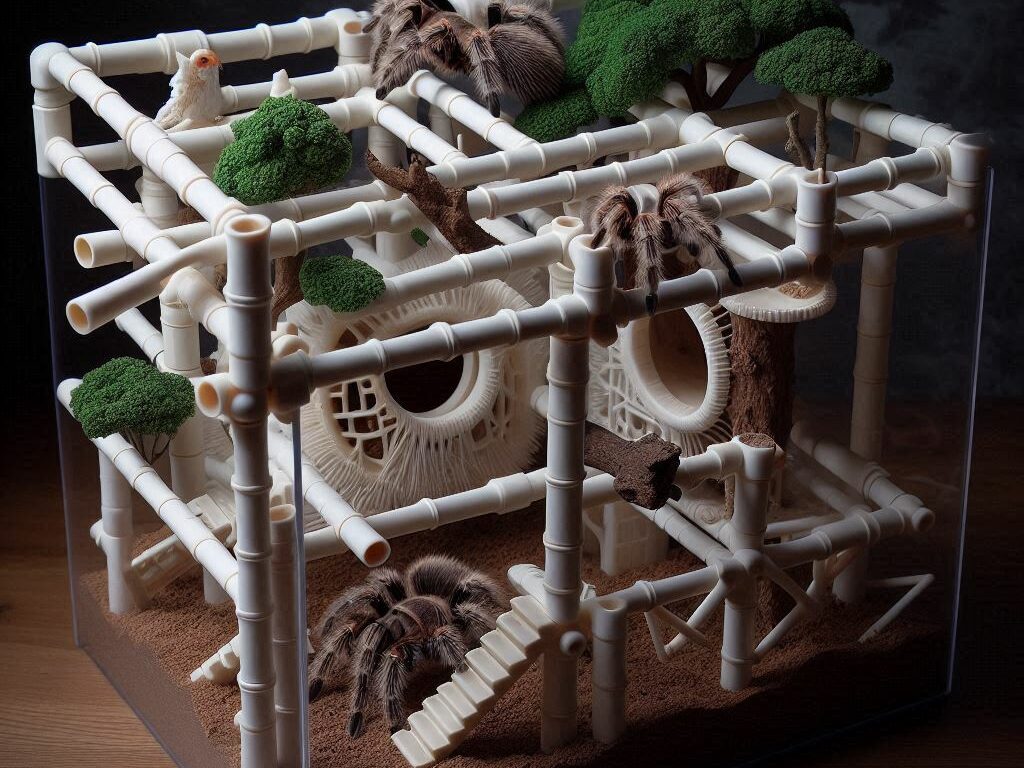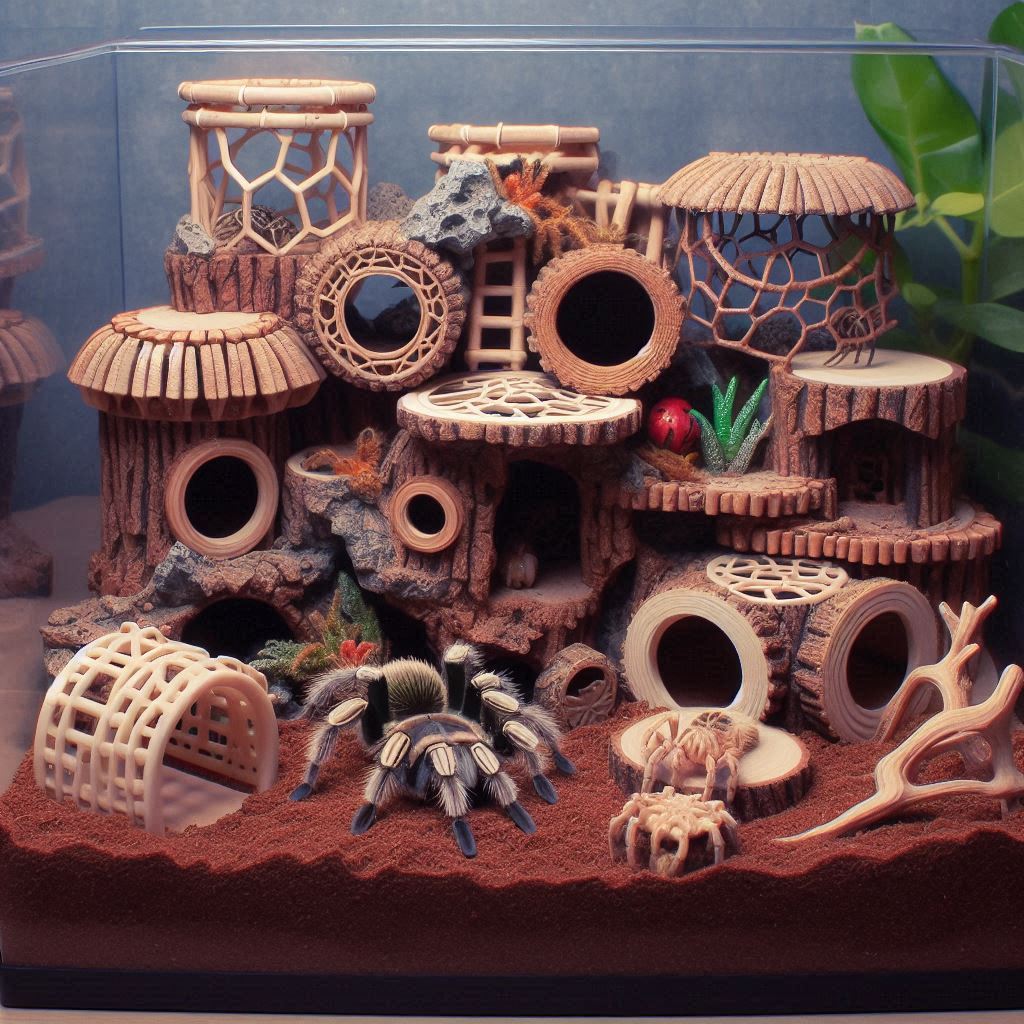Introduction
Table of Contents
Tarantulas make fascinating pets, and one of the most exciting parts of keeping them is designing their enclosures. A well-thought-out tarantula enclosure not only keeps your pet safe but also creates a mini-habitat that mimics its natural environment. In this article, we’ll explore some of the coolest tarantula enclosures, from simple setups to elaborate terrariums. Whether you’re a beginner or an experienced keeper, you’ll find tips and ideas to make your tarantula’s home both functional and aesthetically pleasing.

Why Cool Tarantula Enclosures Matter
Safety First
Cool Tarantula enclosures must prioritize safety. A secure lid is essential to prevent escapes, and ventilation is crucial to maintain proper air circulation without compromising the spider’s ability to escape.
Mimicking Natural Habitat
Tarantulas thrive best in environments that closely resemble their natural habitats. This includes the right substrate, humidity levels, and hiding spots. Mimicking their natural environment helps reduce stress and promotes natural behaviors.
Types of Cool Tarantula Enclosures
Glass Terrariums
Glass terrariums are popular for their visibility and ease of cleaning. They provide an excellent view of your tarantula, making them a great choice for display purposes.
Features
- Clear visibility
- Easy to clean
- Available in various sizes
Downsides
- Heavier and more fragile than other types
- Can be expensive
Plastic Enclosures
Plastic enclosures are lightweight and affordable, making them a practical option for many tarantula keepers. They come in various shapes and sizes, often with secure locking mechanisms.
Features
- Lightweight
- Affordable
- Durable
Downsides
- Less visibility compared to glass
- Can be less aesthetically pleasing
DIY Enclosures
For those who enjoy a creative project, DIY enclosures allow for customization to meet the specific needs of your tarantula. This can be a rewarding way to ensure your spider has the perfect habitat.
Features
- Fully customizable
- Cost-effective
- Can be made from a variety of materials
Downsides
- Requires time and effort to build
- May need regular maintenance
Essential Elements of a Cool Tarantula Enclosures
Substrate
The substrate is the material that lines the bottom of the enclosure. It should be deep enough for burrowing species and absorbent to maintain proper humidity levels.
Recommended Substrates
- Coconut fiber
- Peat moss
- Organic topsoil
Hiding Spots
Tarantulas need places to hide and feel secure. Providing multiple hiding spots reduces stress and mimics their natural behavior.
Examples
- Cork bark
- Hollow logs
- Commercial hideouts
Water Source
A shallow water dish is essential for keeping your tarantula hydrated. Ensure it is shallow enough to prevent drowning but large enough to maintain humidity.
Tips
- Change water regularly
- Clean the dish frequently to prevent mold
Climbing Structures
Some tarantulas enjoy climbing. Including branches and rocks in the enclosure can provide enrichment and encourage natural behaviors.
Suitable Materials
- Branches
- Rocks
- Fake plants
Advanced Enclosure Features
Temperature and Humidity Control
Maintaining the correct temperature and humidity is vital for your tarantula’s health. Use a thermometer and hygrometer to monitor conditions inside the enclosure.
Tips for Control
- Use a heat mat for temperature regulation
- Mist the enclosure to maintain humidity
Bioactive Setups
Bioactive setups include live plants and beneficial microorganisms that create a self-sustaining ecosystem. This type of setup can reduce maintenance and provide a more natural environment for your tarantula.
Benefits
- Reduces waste buildup
- Enhances the visual appeal
- Mimics natural habitat closely
DIY Tarantula Enclosure Project
Materials Needed
- Plastic container or glass aquarium
- Substrate (coconut fiber, peat moss)
- Hiding spots (cork bark, logs)
- Shallow water dish
- Climbing structures (branches, rocks)
Steps to Create
- Prepare the Container: Clean the container thoroughly.
- Add Substrate: Fill the bottom with a 2-4 inch layer of substrate.
- Place Hiding Spots: Arrange hiding spots throughout the enclosure.
- Add Water Dish: Place a shallow water dish in a corner.
- Include Climbing Structures: Position branches and rocks for climbing.
- Monitor Conditions: Set up a thermometer and hygrometer to keep track of temperature and humidity.
Maintenance Tips
Regular Cleaning
Keeping the enclosure clean is essential for your tarantula’s health. Remove uneaten food and waste regularly to prevent mold and bacteria growth.
Monitoring Health
Regularly check your tarantula for signs of health issues such as lethargy, loss of appetite, or abnormal molting. A well-maintained enclosure can help prevent many common problems.
Table of Information: Cool Tarantula Enclosures
| Element | Description |
|---|---|
| Substrate | Coconut fiber, peat moss, organic topsoil |
| Hiding Spots | Cork bark, hollow logs, commercial hideouts |
| Water Source | Shallow dish, change regularly |
| Climbing Structures | Branches, rocks, fake plants |
| Temperature Control | Heat mat, thermometer |
| Humidity Control | Misting, hygrometer |
Conclusion
Creating a cool tarantula enclosure is a fun and rewarding experience. By understanding the needs of your tarantula and incorporating elements that mimic its natural habitat, you can provide a safe, healthy, and visually appealing home for your pet. Whether you choose a glass terrarium, a plastic container, or a DIY project, the key is to prioritize safety, comfort, and enrichment. Happy tarantula keeping!
FAQs
1. What is the best substrate for a tarantula enclosure?
Coconut fiber, peat moss, and organic topsoil are the best substrates because they hold moisture well and allow for burrowing.
2. How often should I clean my tarantula’s enclosure?
You should perform a spot clean weekly and a full clean every 3-6 months to ensure a healthy environment.
3. Can I use live plants in my tarantula’s enclosure?
Yes, live plants can be used in bioactive setups. They help maintain humidity and create a more natural habitat.
4. How do I maintain the correct humidity in the enclosure?
Use a hygrometer to monitor humidity and mist the enclosure regularly to maintain the appropriate levels.
5. What are the signs of a stressed tarantula?
Signs of stress include lethargy, loss of appetite, and excessive webbing or hiding. Ensuring a proper habitat can help reduce stress.

